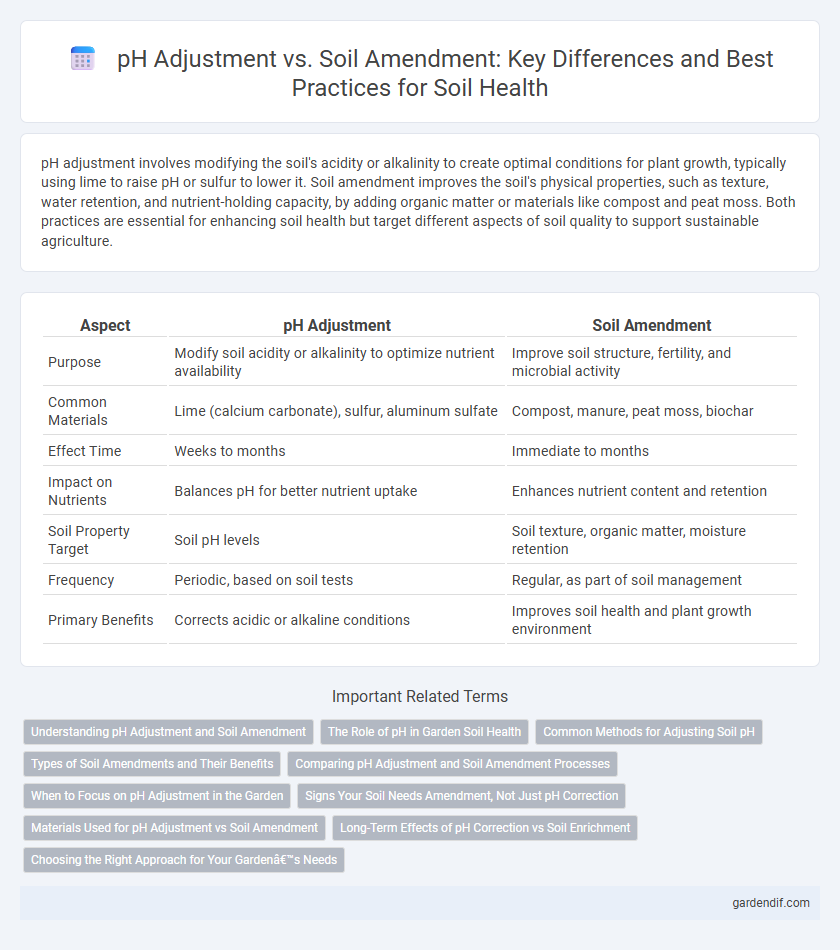
pH Adjustment vs Soil Amendment Illustration
pH adjustment involves modifying the soil's acidity or alkalinity to create optimal conditions for plant growth, typically using lime to raise pH or sulfur to lower it. Soil amendment improves the soil's physical properties, such as texture, water retention, and nutrient-holding capacity, by adding organic matter or materials like compost and peat moss. Both practices are essential for enhancing soil health but target different aspects of soil quality to support sustainable agriculture.
Table of Comparison
| Aspect | pH Adjustment | Soil Amendment |
|---|---|---|
| Purpose | Modify soil acidity or alkalinity to optimize nutrient availability | Improve soil structure, fertility, and microbial activity |
| Common Materials | Lime (calcium carbonate), sulfur, aluminum sulfate | Compost, manure, peat moss, biochar |
| Effect Time | Weeks to months | Immediate to months |
| Impact on Nutrients | Balances pH for better nutrient uptake | Enhances nutrient content and retention |
| Soil Property Target | Soil pH levels | Soil texture, organic matter, moisture retention |
| Frequency | Periodic, based on soil tests | Regular, as part of soil management |
| Primary Benefits | Corrects acidic or alkaline conditions | Improves soil health and plant growth environment |
Understanding pH Adjustment and Soil Amendment
pH adjustment involves modifying soil acidity or alkalinity through the application of substances such as lime to raise pH or sulfur to lower pH, targeting optimal nutrient availability for plants. Soil amendment refers to the addition of organic or inorganic materials like compost, manure, or biochar to improve soil structure, water retention, and microbial activity without necessarily changing pH levels. Understanding the distinction between pH adjustment and soil amendment is essential for effective soil management and achieving specific agronomic goals.
The Role of pH in Garden Soil Health
Soil pH plays a crucial role in nutrient availability and microbial activity, directly impacting garden soil health. pH adjustment involves adding lime or sulfur to raise or lower soil pH, optimizing conditions for plant nutrient uptake. In contrast, soil amendments improve soil structure and fertility but do not specifically target pH levels, making precise pH control essential for maintaining a balanced garden ecosystem.
Common Methods for Adjusting Soil pH
Common methods for adjusting soil pH include liming to raise pH by adding materials like calcium carbonate or dolomite, and sulfur application to lower pH through elemental sulfur or aluminum sulfate. These techniques alter soil acidity or alkalinity efficiently, impacting nutrient availability and microbial activity. Choosing the appropriate amendment depends on initial soil pH, crop requirements, and soil texture for optimal plant growth.
Types of Soil Amendments and Their Benefits
Soil amendments, including organic matter like compost, manure, and peat moss, improve soil structure, water retention, and nutrient availability, enhancing overall plant health. Inorganic amendments such as gypsum and lime specifically target soil texture and pH balance, promoting better root development and nutrient uptake. These types of soil amendments work synergistically to optimize soil conditions, supporting sustainable agriculture and increased crop yields.
Comparing pH Adjustment and Soil Amendment Processes
pH adjustment targets the soil's acidity or alkalinity by applying specific chemicals like lime or sulfur to optimize nutrient availability for plants. Soil amendment improves soil structure, water retention, and microbial activity by adding organic matter such as compost or peat moss. While pH adjustment directly alters chemical soil properties, soil amendment enhances physical and biological soil health, both crucial for effective plant growth.
When to Focus on pH Adjustment in the Garden
Focus on pH adjustment in the garden when soil tests reveal acidity or alkalinity levels that hinder nutrient availability and plant growth, typically outside the optimal pH range of 6.0 to 7.0 for most plants. Correcting soil pH improves nutrient uptake efficiency, addressing specific issues such as iron chlorosis or aluminum toxicity. Soil amendments primarily improve soil structure and organic matter content, whereas pH adjustment targets chemical balance to optimize plant health.
Signs Your Soil Needs Amendment, Not Just pH Correction
Yellowing leaves, stunted growth, and poor crop yields often indicate nutrient imbalances requiring soil amendment rather than simple pH adjustment. Compacted, heavy clay soils with poor drainage show physical problems that amendments like organic matter can improve beyond pH correction. Testing soil nutrient levels and texture helps identify deficiencies such as low phosphorus, potassium, or micronutrients that amendments can effectively address to restore soil health.
Materials Used for pH Adjustment vs Soil Amendment
Materials used for pH adjustment primarily include lime, sulfur, and gypsum, which directly alter the soil's acidity or alkalinity to optimize nutrient availability. Soil amendments encompass organic matter such as compost, manure, peat moss, and biochar, which improve soil structure, moisture retention, and microbial activity without necessarily changing pH. While pH adjustment materials target specific chemical balances, soil amendments enhance overall soil health and fertility through physical and biological improvements.
Long-Term Effects of pH Correction vs Soil Enrichment
pH adjustment primarily targets soil acidity or alkalinity, offering relatively rapid correction to optimize nutrient availability and microbial activity but may require repeated applications for sustained balance. Soil amendments, such as organic matter or mineral supplements, improve soil structure, fertility, and water retention, delivering prolonged benefits that enhance biological function and nutrient cycling over time. Long-term effects of pH correction stabilize nutrient uptake, while amendments contribute to ongoing soil health and resilience, ensuring sustainable crop productivity.
Choosing the Right Approach for Your Garden’s Needs
Soil pH adjustment targets specific acidity or alkalinity levels to optimize nutrient availability for plants, using agents like lime or sulfur based on soil test results. Soil amendment improves overall soil structure, organic matter, and moisture retention through materials such as compost or peat moss, enhancing plant growth conditions beyond just pH balance. Choosing the right approach depends on detailed soil analysis and the specific crop requirements to ensure healthy, productive garden soil.
pH Adjustment vs Soil Amendment Infographic

 gardendif.com
gardendif.com